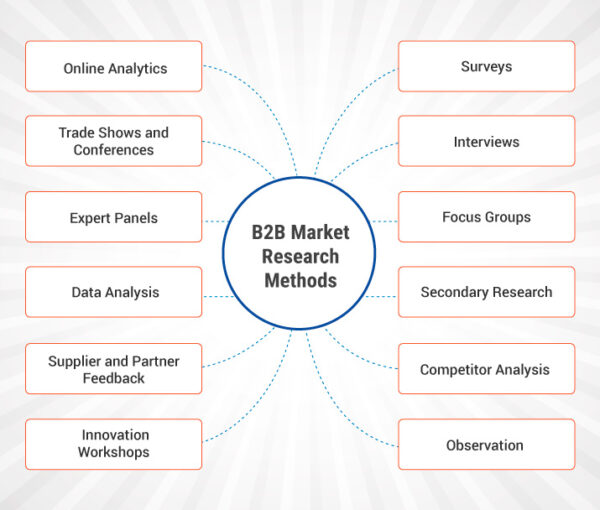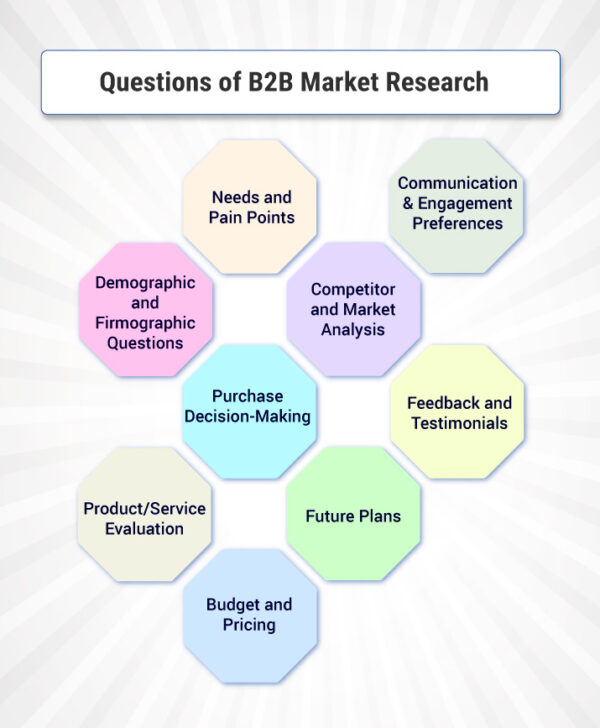Table of Contents
What is B2B Market Research?
B2B market research, short for Business-to-Business market research, is defined as the process of gathering, analyzing, and interpreting data and information about a specific business-to-business market or industry. It focuses on understanding the needs, preferences, behaviors, and trends of businesses as customers or clients.
Here are some key aspects and objectives of B2B market research:
Identifying Target Markets: B2B market research helps businesses identify and define their target customer segments within the business community. This involves understanding the characteristics, demographics, and buying behaviors of potential business customers.
- Market Size and Growth: It helps in estimating the overall size of the market, its growth potential, and the key factors driving that growth. This information is crucial for making strategic decisions about market entry, expansion, or diversification.
- Competitive Analysis: B2B market research involves analyzing competitors operating in the same industry or market. This includes studying their products, pricing strategies, distribution channels, and market share. Understanding the competitive landscape is essential for positioning a business effectively.
- Customer Needs and Preferences: Research helps businesses gain insights into the needs, pain points, and preferences of their B2B customers. This information can be used to develop products or services that better meet those needs.
- Market Trends and Industry Insights: Staying updated on industry trends, emerging technologies, and regulatory changes is crucial for B2B businesses. Market research provides valuable insights into these areas, helping businesses adapt and innovate.
- Feasibility Studies: Before launching a new product or entering a new market, B2B market research can assess the feasibility of such initiatives. It helps in understanding whether there is demand for the product or service and whether the market conditions are favorable.
- Customer Satisfaction and Feedback: B2B businesses often conduct research to gauge customer satisfaction and gather feedback on their products or services. This feedback can be used to improve offerings and strengthen customer relationships.
- Marketing and Sales Strategies: Research findings inform the development of marketing and sales strategies tailored to the unique needs of B2B customers. This includes determining the most effective channels for reaching potential clients.
- Risk Assessment: B2B market research can also help businesses identify potential risks and challenges in the market. This includes economic, political, and technological risks that may impact their operations.
B2B market research can include surveys, interviews, focus groups, data analysis, industry reports, and more. The results of this research are used to make informed decisions, shape business strategies, and ultimately drive growth and profitability in the B2B sector.
Top 13 B2B Market Research Methods

B2B market research employs various methods to gather information and insights about business-to-business markets and industries. The choice of methods depends on the specific research objectives, budget, and available resources. Here are some common B2B market research methods:
1. Surveys: Surveys involve creating structured questionnaires and distributing them to a target audience of businesses. They can be conducted online, via email, phone, or in person. Surveys are a quantitative method and are useful for collecting data on preferences, behaviors, and attitudes.
2. Interviews: In-depth interviews with key stakeholders in the B2B market, such as industry experts, business owners, and decision-makers, can provide valuable qualitative insights. These interviews allow for open-ended questions and deeper exploration of topics.
3. Focus Groups: Focus groups bring together a small group of representatives from target businesses to discuss specific topics or products. It’s a qualitative method that allows for group interactions and in-depth discussions, uncovering insights into shared opinions and perceptions.
4. Secondary Research: Secondary research involves collecting and analyzing existing data and information from sources such as industry reports, government publications, academic studies, and market research reports. This method is cost-effective and provides a foundation for further research.
5. Competitor Analysis: Analyzing competitors in the B2B market involves studying their marketing materials, websites, product offerings, pricing strategies, and customer reviews. This helps identify gaps in the market and informs competitive positioning.
6. Observation: Observational research (such as qualitative or quantitative) entails directly observing businesses in their natural environment. For example, a researcher may observe how businesses use certain products or interact with suppliers. This method provides real-world insights.
7. Online Analytics: Analyzing web traffic, social media engagement, and online behavior of B2B customers can yield valuable insights into their preferences and interests. Tools like Google Analytics and social media analytics platforms can be helpful.
8. Trade Shows and Conferences: Attending industry-specific trade shows and conferences allows businesses to interact with potential customers, gather feedback, and observe emerging trends and technologies in the B2B market.
9. Expert Panels: Forming expert panels or advisory boards consisting of industry experts and professionals can provide valuable insights and guidance on market trends, challenges, and opportunities.
10. Data Analysis: Analyzing existing business data, such as sales figures, customer databases, and transaction records, can reveal patterns and trends in customer behavior and market demand.
11. Supplier and Partner Feedback: Gathering feedback from suppliers, distributors, and business partners can provide insights into market dynamics, supply chain efficiency, and opportunities for collaboration.
12. Innovation Workshops: Hosting workshops or brainstorming sessions with internal teams and external stakeholders can generate ideas for product development and market expansion.
13. Mystery Shopping: Engaging in “mystery shopping” activities, where researchers pose as potential customers to evaluate the customer experience, can provide firsthand insights into the sales process and customer service.
B2B market research often involves a combination of these methods to gain a comprehensive understanding of the market, customer needs, and competitive landscape. The choice of methods should align with the research objectives and budget constraints, and the results should be analyzed carefully to inform strategic decision-making in the B2B sector.
Learn more: What is Market Research?
B2B Market Research Example
Here’s an example of a B2B market research scenario
Scenario: A company that manufactures industrial machinery wants to expand its product line by introducing a new type of heavy-duty construction equipment. However, before making significant investments in product development and marketing, they decided to conduct B2B market research to assess the feasibility and potential demand for their new product in the construction industry.
B2B Market Research Process
- Objective Setting: The company defines its research objectives, which include determining the market size, identifying target customer segments, understanding competitors, and gauging potential interest in their new construction equipment.
- Market Segmentation: Researchers identify and segment potential customers within the construction industry. This could include construction companies, contractors, and equipment rental businesses.
- Surveys and Interviews: Researchers create a survey questionnaire and conduct in-depth interviews with key stakeholders in the construction industry. The survey asks questions about their equipment needs, preferences, pain points, and willingness to adopt new technology.
- Competitor Analysis: The company analyzes competitors in the heavy-duty construction equipment market. They assess competitor products, pricing strategies, distribution channels, and market share.
- Secondary Research: The research team collects data from industry reports, government publications, and market research studies to gather information on construction industry trends, regulatory changes, and economic forecasts.
- Focus Groups: A series of focus groups are conducted with construction industry professionals to gain qualitative insights into their perceptions of the new equipment, potential barriers to adoption, and desired features.
- Data Analysis: After collecting survey responses, interview transcripts, and other data, the research team analyzes the information to identify trends, preferences, and areas of opportunity.
- Feasibility Assessment: The company evaluates the feasibility of launching the new product. This includes assessing whether there is a demand for heavy-duty construction equipment with the proposed features and if market conditions are favorable.
- Product Development: Based on the research findings, the company refines its product concept and design, ensuring it aligns with customer needs and preferences.
- Marketing and Sales Strategy: The research informs the development of marketing materials, pricing strategies, and sales tactics tailored to the construction industry’s specific requirements and pain points.
- Launch and Monitoring: The company launches the new construction equipment product, closely monitoring customer feedback and sales performance. They continue to adjust their strategies based on ongoing market insights.
- Feedback Loop: The company establishes a feedback loop with customers, collecting ongoing feedback on product performance, customer service, and any necessary improvements.
In this example, B2B market research helped the company make informed decisions about entering the heavy-duty construction equipment market. It guided product development, marketing strategies, and ongoing customer engagement, ultimately increasing the likelihood of success in a competitive B2B market.
Learn more: What is Market Research Analysis?
Top 9 Questions of B2B Market Research

When conducting B2B market research, it’s essential to formulate well-crafted questions that help you gather valuable insights about your target audience, industry, and market. Here are some sample B2B market research questions to consider:
1. Demographic and Firmographic Questions:
- What is the size of your company in terms of annual revenue and number of employees?
- In which industry or sector is your company currently active?
- How long has your company been in business?
- What is the geographical location or scope of your operations?
- Are there any specific regulatory or compliance requirements that impact your business?
2. Needs and Pain Points:
- What are the most significant challenges your company faces in [industry/area]?
- What specific needs or problems do you encounter when [performing a particular task or process]?
- Are there any unmet needs or pain points related to [your product or service category]?
- How do these challenges impact your company’s productivity and profitability?
3. Product/Service Evaluation:
- How satisfied are you with your current [product/service] providers?
- What features or capabilities are most important to you when selecting a [product/service]?
- Are there any specific improvements or enhancements you’d like to see in [product/service] offerings?
- What factors influence your decision to switch or continue using a [product/service] provider?
4. Purchase Decision-Making:
- Who are the key decision-makers within your organization when it comes to [product/service] purchases?
- What criteria do you use to evaluate and select B2B vendors or suppliers?
- What is your typical decision-making process for major purchases?
- Are there specific budget constraints or approval processes you follow?
5. Competitor and Market Analysis:
- Are there any competitors in the [product/service] space that you admire or prefer?
- How do you perceive the strengths and weaknesses of your current competitors?
- Are there any emerging trends or technologies in the market that you find intriguing or valuable?
6. Communication and Engagement Preferences:
- How do you prefer to receive information about new products or services in your industry?
- Are you active on any B2B social media platforms or industry-specific forums?
- What type of content or resources do you find most useful in your decision-making process?
7. Budget and Pricing:
- What is your budget range for [product/service] purchases?
- How do you typically assess the value and ROI of your B2B investments?
- Are you willing to pay a premium for [specific features/benefits]?
8. Future Plans:
- What are your company’s growth and expansion plans for the next [timeframe]?
- Are there any upcoming projects or initiatives that will impact your [product/service] needs?
- How do you see your industry evolving in the coming years, and how does this affect your requirements?
9. Feedback and Testimonials:
- Have you provided feedback or testimonials to your current B2B vendors or suppliers?
- What motivates you to share positive feedback or endorsements?
- Are there specific challenges or concerns that would prompt you to provide feedback?
These questions should serve as a starting point for your B2B market research efforts. Depending on your specific goals and industry, you may need to tailor your questions further to gather the most relevant and actionable insights. Additionally, consider using a mix of quantitative surveys and qualitative interviews or focus groups to gain a comprehensive understanding of your B2B audience.
Learn more: What is Competitive Research?
Most Recent Blogs
Explore the latest innovation insights and trends with our recent blog posts.










